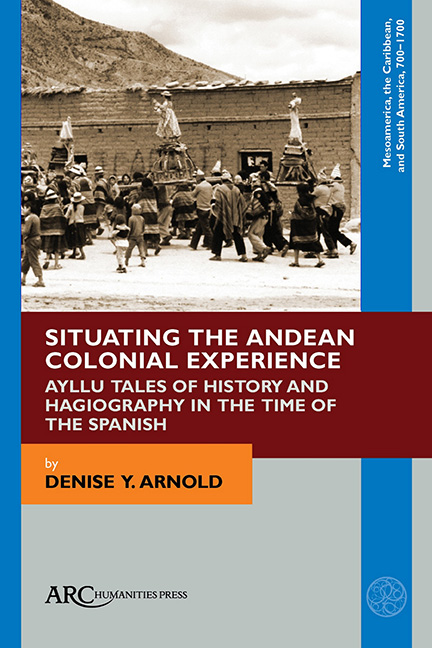 Situating the Andean Colonial Experience
Situating the Andean Colonial Experience Book contents
- Frontmatter
- Contents
- List of Illustrations
- Note About the Spelling of Toponyms and Proper Names
- Acknowledgements
- Maps
- Introduction
- PART ONE THE ORAL HISTORY OF QAQACHAKA
- PART TWO THE COLONIAL CACIQUES IN ORAL AND WRITTEN HISTORY
- PART THREE QAQACHAKA MARKA
- PART FOUR THE SAINTS APPEAR
- PART FIVE THE RELIGIOUS PRACTICES OF QAQACHAKA MARKA
- Some Conclusions
- Glossary
- Appendix A Document C of Don Franco Quispe Maraza
- Appendix B Document K of Don Franco Quispe Maraza
- Bibliography
- Thematic Index
- Index of Toponyms
Chapter 12 - The Origins of the Ritual Practices Around the Church
Published online by Cambridge University Press: 22 June 2021
- Frontmatter
- Contents
- List of Illustrations
- Note About the Spelling of Toponyms and Proper Names
- Acknowledgements
- Maps
- Introduction
- PART ONE THE ORAL HISTORY OF QAQACHAKA
- PART TWO THE COLONIAL CACIQUES IN ORAL AND WRITTEN HISTORY
- PART THREE QAQACHAKA MARKA
- PART FOUR THE SAINTS APPEAR
- PART FIVE THE RELIGIOUS PRACTICES OF QAQACHAKA MARKA
- Some Conclusions
- Glossary
- Appendix A Document C of Don Franco Quispe Maraza
- Appendix B Document K of Don Franco Quispe Maraza
- Bibliography
- Thematic Index
- Index of Toponyms
Summary
And in this space sprouts a very small herb …
Ruiz de Montoya (1639, 3 and 31), talking about the traces left by Saint Thomas in the West Indies (that is to say the Americas)ONCE THE CHURCH and its two towers were built, and now with the whole ensemble of saint-gods safely inside, “like Chullpas seated there,” the Qaqachaka ancestors felt the need to practice rites there to guarantee their wellbeing. In the case of the two towers, there was the danger that they could “fall down,” with a lightning strike or something similar. Here again, the purpose of the ancestors was to reinvoke what they could of their own former customs in this new colonial setting.
The descriptions by Don Severo Antachoque of the weekly rituals to ensure that two towers “stand continuously” reveal this parallelism between the rites made to the new ritual sites opened up below the church towers, and the rites made formerly to other local sites, such as the “chests” on top of the guardian mountains (called uywiri) of the Qaqachaka territory. Both of these sites for burying offerings are called liwaña, “to offer or to feed.” The difference is that the offering rites at the foot of the church towers were under the charge of the mayordomos grouped in the main pueblo, whereas those to the guardian mountains were conducted by yatiris:
As a consequence (of constructing the church towers), the grandfathers asked among themselves, saying, “How shall we make them stand up? So now, what shall we do with them?”
Then the grandfathers opted for certain agreements. First they prepared an offering to feed the tower. The offering place to “father tower” is tatala turri liwaña and to “mother tower” is mamala turri liwaña, quite separately. They made their offerings there, in those places, to “make them stand” (sayjatas), because the towers could fall down, couldn't they?
That's why they just pronounced the sound “q’aw.” They’d gone to consult the yatiris, and from yatiri to yatiri. “What shall we do, how will we make them stand up? If we don’t, then lightning, q’aw, will strike tatala turri … And then it will strike the church too, q’aw. It won't be any good,” they said.
- Type
- Chapter
- Information
- Situating the Andean Colonial ExperienceAyllu Tales of History and Hagiography in the Time of the Spanish, pp. 249 - 274Publisher: Amsterdam University PressPrint publication year: 2021


